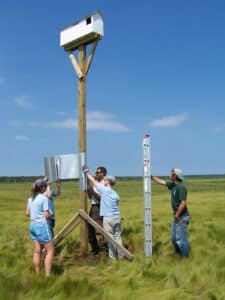Coastal Barn Owl Project
Coastal Barn Owl Project
Why It Matters
Barn owls (Tyto alba) are globally widespread, found on all continents except Antarctica. Their numbers in New Jersey, however, are in steep decline. Barn owls depend on open grasslands that support small rodents, and they require secondary cavities for nesting (meaning they can’t make their own cavity).
The downward population trend in New Jersey is associated with urban sprawl, development of former agricultural lands, and agricultural changes from dairy farms to row crops (Colvin et. at. 2019). Another unseen threat to barn owls is exposure to poisons and pesticides targeting their prey, specifically rodenticides. The population of barn owls in the interior areas of New Jersey has plummeted as their foraging areas continue to disappear. The stronghold in New Jersey has become the coastal wetlands population, where the habitat provides better long-term availability of foraging habitat and prey (Colvin et. al. 2019).
Research has shown that unfortunately, this coastal population is also experiencing a decline. The Barn Owl Research Foundation has been studying the barn owl population in southwestern New Jersey for 40 years. Their barn owl boxes, located near coastal wetlands along the Delaware Bay and River in Cumberland and Salem counties have been closely monitored since 1980. Although barn owl populations naturally fluctuate year to year, related to weather conditions and prey availability, numbers have been showing a steady decline (Colvin et. al. 2019). The number of nests in the study site has declined from 36 nests to 11 nests just over the last 10 years. The 2019 season showed a high population turnover, a record low number of nests, smaller brood sizes, and higher chick mortality rates (mostly starvation). This trend is likely associated with increased coastal flooding and higher tides affecting the prey source (Colvin et. al. 2019). The fate of barn owls is therefore closely linked to climate change.
Conservation Efforts
 The two factors necessary for the conservation of barn owls are the conservation of good foraging habitat and the use of properly designed and installed boxes in those areas (Colvin et. at. 2019). A key component may be placing these nestboxes near upland foraging areas (not prone to back bay flooding).
The two factors necessary for the conservation of barn owls are the conservation of good foraging habitat and the use of properly designed and installed boxes in those areas (Colvin et. at. 2019). A key component may be placing these nestboxes near upland foraging areas (not prone to back bay flooding).
Conserve Wildlife Foundation has been engaged in barn owl conservation since 2006, after installing several nestboxes in coastal portions of Ocean and Burlington Counties as mitigation projects for NJDOT/NJ Turnpike Authority. Then in 2020, we launched the Coastal Barn Owl Project in partnership with NJDEP Fish & Wildlife and Conservation Science Global. Using the tried and true nestbox design that has been proven successful by the Barn Owl Research Foundation and installing boxes in areas of suitable foraging habitat.
Only a handful of barn owl boxes have been placed along the Atlantic coast in comparison with the extensive number of boxes near saltmarsh habitat in Salem and Cumberland Counties. With a seemingly vast amount of habitat, the limiting factor for the barn owl population here may be nesting cavities, as in Atlantic coastal areas, barn owls have been found nesting under bridges, buildings, and unoccupied peregrine falcon nestboxes.
Installing nest boxes should make monitoring easier since barn owls will typically shift to a nearby box from alternative sites such as tree cavities (Colvin et. al. 2019). CWF initiated this fieldwork in Cape May County but has also installed nestbox in Monmouth County (2023) and is now expanding efforts to Ocean and Burlington Counties (2025). Volunteers will be recruited to help monitor the nest boxes for occupancy and nest outcomes.